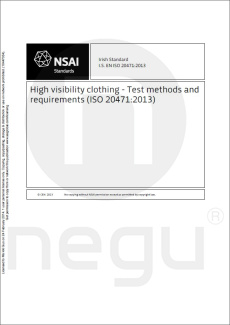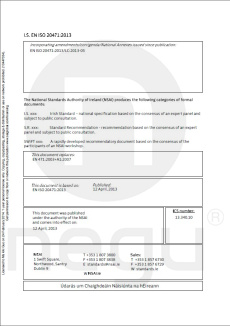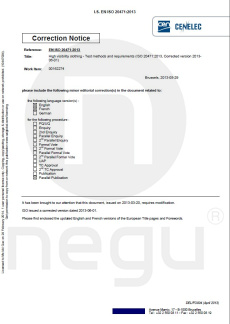I.S. EN ISO 20471-2013 High Visibility Clothing - Test Methods and Requirements
ISO 20471-2013
High Visibility Clothing - Test Methods and Requirements
(高可视性警示服的测试方法及要求)
Foreword
ISO (the International Organization for Standardization) is a worldwide federation of national standards bodies (ISO member bodies). The work of preparing International Standards is normally carried out through ISO technical committees. Each member body interested in a subject for which a technical committee has been established has the right to be represented on that committee. International organizations, governmental and non-governmental, in liaison with ISO, also take part in the work. ISO collaborates closely with the International Electrotechnical Commission (IEC) on all matters of electrotechnical standardization.



International Standards are drafted in accordance with
the rules given in the ISO/IEC Directives, Part 2.
The main task of technical committees is to prepare
International Standards. Draft International Standards adopted by the technical
committees are circulated to the member bodies for voting. Publication as an
International Standard requires approval by at least 75 % of the member
bodies casting a vote.
Attention is drawn to the possibility that some of the
elements of this document may be the subject of patent rights. ISO shall not be
held responsible for identifying any or all such patent rights.
ISO 20471 was prepared by Technical Committee ISO/TC 94, Personal safety — Protective clothing and equipment, Subcommittee SC 13, Protective clothing.
This corrected version of ISO 20471:2013 incorporates the
following correction:
· — in the fourth paragraph of subclause 4.1 the requirement
concerning the sleeves of a class 3 garment has been corrected.
Introduction
The performance of the conspicuity-enhancing materials to
be used for high risk-related visibility clothing is specified photometrically
together with minimum areas and placement (design) requirements.
Conspicuity is the property that makes an object readily
attract visual attention. This is a particularly important feature in complex
environments which have visually competing objects. Conspicuity is determined
by an object’s luminance contrast, colour contrast, pattern and design, and
motion characteristics relative to the ambient background against which it is
seen.
Three classes of garment are defined based on three
different minimum areas of retroreflective, fluorescent and/or combined
performance materials. Each of these classes will provide a different level of
conspicuity, class 3 being the class that provides the highest degree of
conspicuity against most backgrounds found in urban and rural situations in
daylight and in night time. Users should select the required class of
performance based on a risk assessment of the location/situation in which the
protection afforded by clothing to this International Standard is required.
This International Standard contains requirements
relating to risk assessment and risk analysis of high visibility garments.
Possible designs illustrating the placement of retroreflective materials are
included within the standard. Ergonomic factors such as fit/sizing, comfort,
and range of motion of the wearer should be considered when selecting the most
appropriate configuration of retroreflective and fluorescent materials within
the garment.
Selection and use of high visibility clothing can vary
among user countries and may be subject to local regulations. This
International Standard contains requirements relating to risk assessment of the
condition in which the high visibility clothing is to be used. This will involve
consideration of the factors which may affect an observer’s ability to detect
that a person is present. The observer needs both to perceive and to recognize
the wearer and then needs to be able to take appropriate avoidance action. The
wearing of a conspicuity-enhancing high visibility garment does not guarantee
that the wearer will be visible under all conditions.
The minimum requirements given within this International
Standard are determined by the specific test methods and their assigned
measuring values. The tests are partly performed on new materials and partly on
preconditioned materials. By preconditioning (e.g. folding of retroreflective
material) a load of the materials is simulated. However, it should be noted
that laboratory testing may not represent real life conditions. The conspicuity
performance of a garment will depend on usage (e.g. dirt, solar irradiation),
care (e.g. cleaning agent, repair), storage (e.g. dust-free, lightproof), etc.
1 Scope
This International Standard specifies requirements for
high visibility clothing which is capable of visually signalling the user's
presence. The high visibility clothing is intended to provide conspicuity of
the wearer in any light condition when viewed by operators of vehicles or other
mechanized equipment during daylight conditions and under illumination of
headlights in the dark. For further information concerning risk situations, see Annex A.
This International Standard is not applicable to
medium-risk and low-risk situations.
Performance requirements are included for colour and
retroreflection as well as for the minimum areas and for the placement of the
materials in protective clothing.
2 Normative
references
The following referenced documents are indispensable for the application of this document. For dated references, only the edition cited applies. For undated references, the latest edition of the referenced document (including any amendments) applies.
ISO 105-A02, Textiles — Tests for colour fastness — Part A02: Grey scale for assessing change in colour
ISO 105-A03, Textiles — Tests for colour fastness — Part A03: Grey scale for assessing staining
ISO 105-B02:1994, Textiles — Tests for colour fastness — Part B02: Colour fastness to artificial light: Xenon arc fading lamp test
ISO 105-C06, Textiles — Tests for colour fastness — Part C06: Colour fastness to domestic and commercial laundering
ISO 105-D01, Textiles — Tests for colour fastness — Part D01: Colour fastness to drycleaning using perchloroethylene solvent
ISO 105-E04, Textiles — Tests for colour fastness — Part E04: Colour fastness to perspiration — Part E04: Colour fastness to perspiration
ISO 105-N01, Textiles — Tests for colour fastness — Part N01: Colour fastness to bleaching: Hypochlorite — Tests for colour fastness — Part N01: Colour fastness to bleaching: Hypochlorite
ISO 105-X11, Textiles — Tests for colour fastness — Part X11: Colour fastness to hot pressing — Tests for colour fastness — Part X11: Colour fastness to hot pressing
ISO 105-X12, Textiles — Tests for colour fastness — Part X12: Colour fastness to rubbing
EN 343, Protective clothing — Protection against rain
CIE 15, Colorimetry
CIE 54.2, Retroreflection — Definition and measurement
3 Terms
and definitions
For the purposes of this document, the following terms
and definitions apply.
3.1
high visibility clothing
warning clothing intended to provide improved conspicuity
in situations where the risk of not being seen is high
3.2
fluorescent material
material that emits electromagnetic radiation at visible
wavelengths longer than those absorbed
3.3
background material
coloured fluorescent material intended to be highly
conspicuous, but not intended to comply with the requirements of this International
Standard for retroreflective material
3.4
retroreflective material
material which is a retroreflector but which is not
intended to comply with the requirements of this International Standard for
background material
3.5
separate-performance material
material intended to exhibit either background or
retroreflective properties but not both
3.6
combined-performance material
material intended to exhibit both background and
retroreflective properties
3.7
orientation-sensitive material
material having coefficients of retroreflection that
differ by more than 15 % when measured at the two rotation angles ε1 = 0° and ε2 = 90°
3.8
torso
thorax and abdomen or section of the body to which the
limbs, head and neck are attached
3.9
long sleeve
(1/1 arm)
part of a garment that is completely covering the arm
3.10
road
traffic-related area with moving vehicles
EXAMPLE:
Cycling path, harbour, airport, railway track and car
park.
3.11
active road user
person on the road, participating in the traffic and with
the attention on the traffic
Note 1 to entry: e.g. cyclist using the road and pedestrian
using the road.
3.12
passive road user
person on the road, not participating in vehicular
traffic and with attention focused on something other than traffic
EXAMPLE:
Road worker, person in emergency situation.
3.13
outer shell
outermost material of which the warning clothing is made
Bibliography
|
ISO 3175-2, Textiles — Professional care,
drycleaning and wetcleaning of fabrics and garments — Part 2:
Procedure for testing performance when cleaning and finishing using
tetrachloroethene |
|
|
ISO 3758, Textiles — Care labelling code
using symbols |
|
|
ISO 3759, Textiles — Preparation,
marking and measuring of fabric specimens and garments in tests for
determination of dimensional change |
|
|
ISO 6330, Textiles — Domestic washing
and drying procedures for textile testing |
|
|
ISO 7000, Graphical symbols for use on
equipment — Registered symbols1 |
|
|
ISO 15797, Textiles — Industrial washing
and finishing procedures for testing of workwear |
|
|
ISO 30023, Textiles — Qualification
symbols for labelling workwear to be industrially laundered |
|
|
EN 530, Abrasion resistance of protective
clothing material — Test methods |
|
|
EN 1150, Protective clothing —
Visibility clothing for non-professional use — Test methods and
requirements |
|
|
EN 13356, Visibility accessories for
non-professional use — Test methods and requirements |
Etc
温馨提示:由于ISO 20471-2013 High Visibility Clothing-Test Methods and Requirements(高可视性警示服的测试方法及要求)标准信息内容太丰富,篇幅太长,耐戈友小编暂将简介内容概述如上,有兴趣或者有该方面需要的朋友,请联系耐戈友网站客服索要完整版本标准信息。
下一篇:BS EN 1149-5-2008_防静电服英国/欧洲标准 本文由耐戈友整理发布,转载请注明出处!
链接地址 http://www.negu.com.cn/?article-187.html
- [2017-03-15]GB/T28468-2012中小学生交通安全反光校服国家标准【免费下载】
- [2014-08-25]BS EN 1149-5-2008_防静电服英国/欧洲标准
- [2014-08-25]BS EN 533-1997_阻燃防护服英国/欧洲标准
- [2014-08-19]BS EN 343-2003+A1-2007 Protective clothing—Protection against rain(防护服-防雨防护服英国|欧洲标准)
- [2016-08-10]焊接防护服标准GB-15701-1995JZO
- [2016-08-10]一般防护服标准GB/T13661-1992




